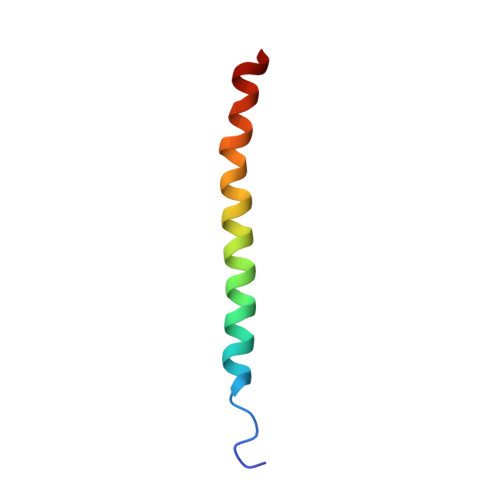Conformationally organized lysine isosteres in Streptococcus pyogenes M protein mediate direct high-affinity binding to human plasminogen.
Yuan, Y., Zajicek, J., Qiu, C., Chandrahas, V., Lee, S.W., Ploplis, V.A., Castellino, F.J.(2017) J Biol Chem 292: 15016-15027
- PubMed: 28724633
- DOI: https://doi.org/10.1074/jbc.M117.794198
- Primary Citation of Related Structures:
5V4U - PubMed Abstract:
The binding of human plasminogen (hPg) to the surface of the human pathogen group A Streptococcus pyogenes (GAS) and subsequent hPg activation to the protease plasmin generate a proteolytic surface that GAS employs to circumvent host innate immunity. Direct high-affinity binding of hPg/plasmin to pattern D GAS is fully recapitulated by the hPg kringle 2 domain (K2 hPg ) and a short internal peptide region (a1a2) of a specific subtype of bacterial surface M protein, present in all GAS pattern D strains. To better understand the nature of this binding, critical to the virulence of many GAS skin-tropic strains, we used high-resolution NMR to define the interaction of recombinant K2 hPg with recombinant a1a2 (VKK38) of the M protein from GAS isolate NS455. We found a 2:1 (m/m) binding stoichiometry of K2 hPg /VKK38, with the lysine-binding sites of two K2 hPg domains anchored to two regions of monomeric VKK38. The K2 hPg /VKK38 binding altered the VKK38 secondary structure from a helical apo-peptide with a flexible center to an end-to-end K2 hPg -bound α-helix. The K2 hPg residues occupied opposite faces of this helix, an arrangement that minimized steric clashing of K2 hPg We conclude that VKK38 provides two conformational lysine isosteres that each interact with the lysine-binding sites in K2 hPg Further, the adoption of an α-helix by VKK38 upon binding to K2 hPg sterically optimizes the side chains of VKK38 for maximal binding to K2 hPg and minimizes steric overlap between the K2 hPg domains. The mechanism for hPg/M protein binding uncovered here may facilitate targeting of GAS virulence factors for disease management.
Organizational Affiliation:
From the W.M. Keck Center for Transgene Research.














